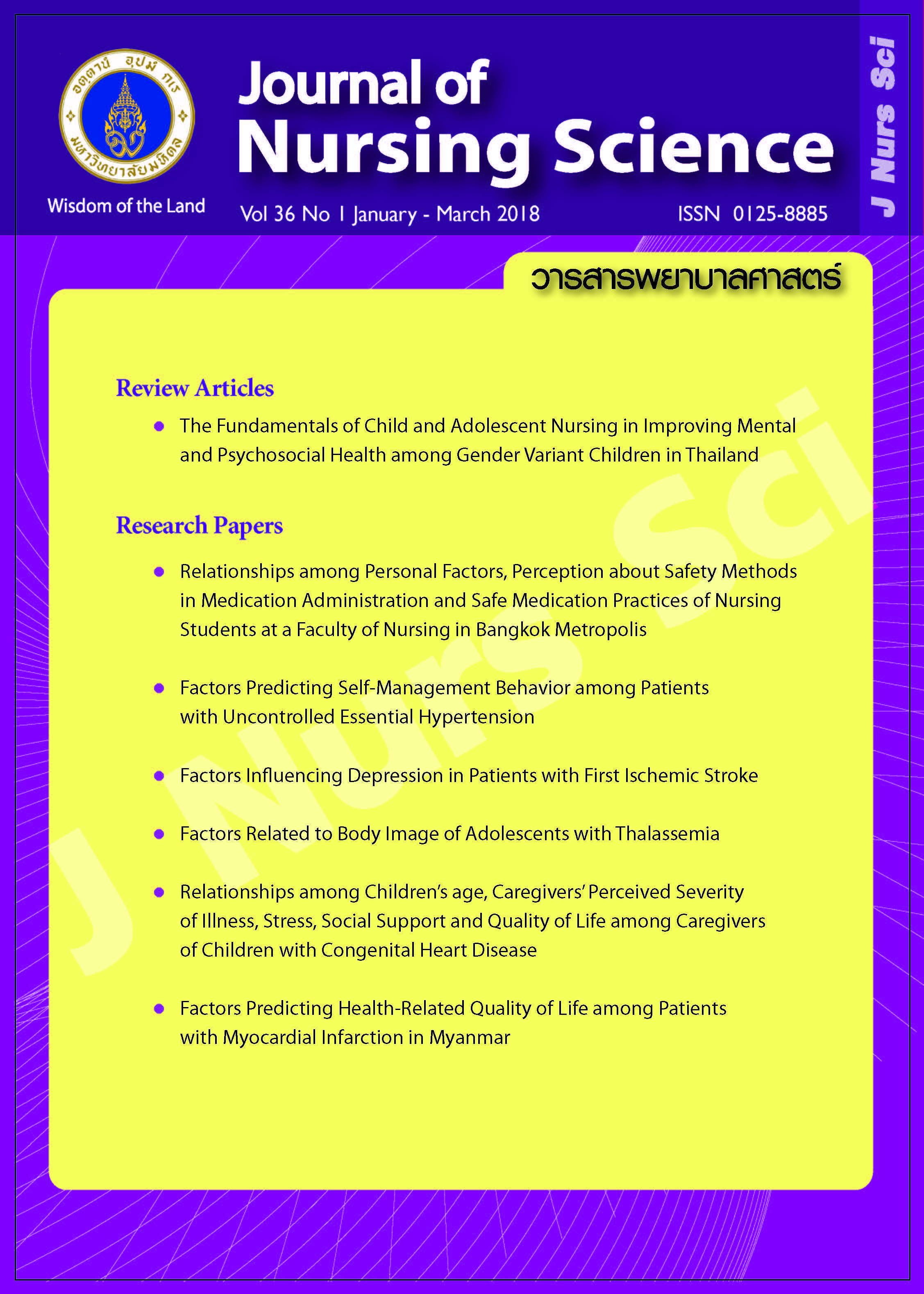Factors Predicting Health-Related Quality of Life among Patients with Myocardial Infarction in Myanmar
Main Article Content
Abstract
Purpose: To examine the predictive power of age, sex, depression, and social support on health-related quality of life among patients with myocardial infarction in Myanmar.
Design: Predictive correlational design.
Methods: The sample consisted of 100 myocardial infarction patients diagnosed for at least three months and came to follow-up at Cardiology Clinic, Yangon General Hospital, Myanmar. Data were collected by using demographic form, the World Health Organization Quality of Life Questionnaire (WHOQoL-BREF), the Patients Health Questionnaire (PHQ-9), and the Social Support Questionnaire. Descriptive statistics and multiple regression analysis were used for data analysis.
Main findings: The mean score of the overall health-related quality of life was found to be
moderate (M = 82.02, SD = 8.84). The mean age of the samples was 60.6 years (SD = 8.98) and 67% were men. The majority of the sample had mild depression (M = 5.23, SD = 6.10). Sixty percent of them perceived high-level social support. In multiple regression analysis, age, sex, depression, and social support jointly accounted for 34.1% of the variance in overall health-related quality of life (R2 = .341, F(4, 95) = 7.327, p < .001). Depression was the only one variable significantly predicting health-related quality of life (β = - .505, p < .001).
Conclusion and recommendations: Findings from this study revealed moderate health-related quality of life in Myanmar patients with myocardial infarction and depression was the important predictor. The patients should be assessed for depression regularly to reduce depressive symptoms and improve health-related quality of life.
Article Details
Copyright Notice: Nursing Science Journal of Thailand has exclusive rights to publish and distribute the manuscript and all contents therein. Without the journal’s permission, the dissemination of the manuscript in another journal or online, and the reproduction of the manuscript for non-educational purpose are prohibited.

Disclaimer: The opinion expressed and figures provided in this journal, NSJT, are the sole responsibility of the authors. The editorial board bears no responsibility in this regard.
References
2. Gaziano TA, Bitton A, Anand S, Abrahams-Gessel S, Murphy A. Growing epidemic of coronary heart disease in low-and middle-income countries. Curr Probl Cardiol. 2010;35(2):72-115.
3. Hlaing SK. The number of patients with cardiovascular diseases at Cardiovascular Outpatient Department, Yangon General Hospital during 2013-2015 [personal survey]. Yangon, Myanmar: (Unpublished); 2016.
4. Zuckerman IH, Yin X, Rattinger GB, Gottlieb SS, Wastila LS, Pierce SA, et al. Impact of exposure to evidence-based pharmacotherapy on outcomes following acute myocardial infarction in older adults. J Am Geriatr Soc. 2012;60(10):1854-61.
5. Anderson JL, Adams CD, Antman EM, Bridges CR, Califf RM, Casey DE, et al. ACC/AHA 2007 guidelines for the management of patients with unstable angina/non–ST-elevation myocardial infarction: executive summary. Circulation. 2007;116(7):803-77.
6. Panthee B, Kritpracha C, Chinnawong T. Correlation between coping strategies and quality of life among myocardial infarction patients in Nepal. Nurse Media Journal of Nursing. 2011;1(2):187-94.
7. Norekval TM, Wahl AK, Fridlund B, Nordrehaug JE, Larsen TW, Hanestad BR. Quality of life in female myocardial infarction survivors: a comparative study with a randomly selected general female population cohort. Health Qual Life Outcomes. 2007 Oct 30;5:58. doi: 10.1186/1477-7525-5-58. PubMed PMID: 17971206; PubMed Central PMCID: PMC2174935.
8. Hawkes AL, Patrao TA, Ware R, Atherton JJ, Taylor CB, Oldenburg BF. Predictors of physical and mental healthrelated quality of life outcomes among myocardial infarction patients. BMC Cardiovasc Disord. 2013 Sep 10;13:69. doi: 10.1186/1471-2261-13-69. PubMed PMID:24020831; PubMed Central PMCID: PMC3847683.
9. Wang W, Chow A, Thompson DR, Koh K, Kowitlawakul Y, He HG. Predictors of health-related quality of life among patients with myocardial infarction. West J Nurs Res. 2016;38(1):43-56.
10. Hosseini SH, Ghaemian A, Mehdizadeh E, Ashraf H. Contribution of depression and anxiety to impaired quality of life in survivors of myocardial infarction. Int J Psychiatry Clin Pract. 2014;18(3):175-81.
11. Dickens CM, McGowan L, Percival C, Tomenson B, Cotter L, Heagerty A, et al. Contribution of depression and anxiety to impaired health-related quality of life following first myocardial infarction. Br J Psychiatry.
2006;189(4):367-72.
12. Zhan L. Quality of life: conceptual and measurement issues. J Adv Nurs. 1992;17(7):759-800.
13. Wang W, Thompson DR, Ski CF, Liu M. Health-related quality of life and its associated factors in Chinese myocardial infarction patients. Eur J Prev Cardio. 2014;21(3):321-9.
14. Barbareschi G, Sanderman R, Kempen GI, Ranchor AV. Socioeconomic status and the course of quality of life in older patients with coronary heart disease. Int J Behav Med. 2009;16(3):197-204.
15. Faul F, Erdfelder E, Buchner A, Lang AG. Statistical power analyses using G* Power 3.1: tests for correlation and regression analyses. Behav Res Methods. 2009;41(4):1149-60.
16. Naing MM, Nanthamongkolchai S, Munsawaengsub C. Quality of life of the elderly people in Einme Township Irrawaddy Division, Myanmar. Asia Journal of Public Health. 2010;1(2):4-10.
17. Spitzer RL, Kroenke K, Williams JB. Validation and utility of a self-report version of PRIME-MD: the PHQ primary care study. Primary care evaluation of mental disorders. Patient health questionnaire. JAMA.
1999;282(18):1737-44.
18. Zaw ZA. Quality of life of type 2 diabetes patients in Mandalay, Myanmar [master’s thesis]. Bangkok: Mahidol University; 2014. 87 p.
19. Brodaty H, Pond D, Kemp NM, Luscombe G, Harding L, Berman K, et al. The GPCOG: a new screening test for dementia designed for general practice. J Am Geriatr Soc. 2002;50(3):530-4.
20. Lwe Say Paw Hla. Factors influencing adherence to therapeutic regimens in patients with type 2 diabetes mellitus in Yangon, Myanmar [dissertation]. Bangkok: Mahidol University; 2017. 227 p.
21. Williams RB. Cardiology patient page. Depression after heart attack: why should I be concerned about depression after a heart attack? Circulation. 2011;123(25):e639-40.
22. Knodel J. The situation of older persons in Myanmar: results from the 2012 survey of older persons. Yangon: Help Age International Myanmar Country Office; 2013.


